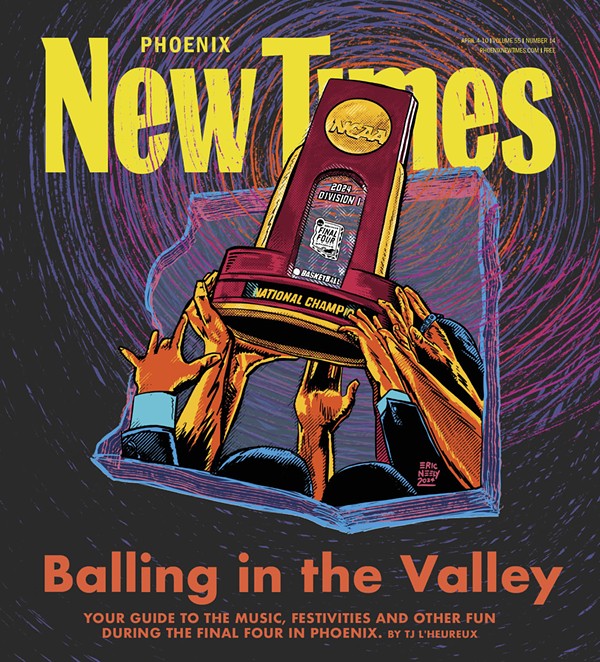There's actually enough foliage to lower the temperature here, in this little corner of the desert where the tall date palms turn the shaded grass a deep, lush green. Neat rows of citrus trees provide a buffer from 51st and Northern avenues.
Behind the house, which looms like a grand hotel, cattle and sheep graze near a beat-up barn. They are the only residents of 140 acres that will soon be a bustling new neighborhood.
Cheerful roses line a little white fence, but the house itself is tired. It predates Arizona's statehood and Henry Ford's Model T. The house has stood through the Great Depression, the New Deal, the civil rights movement and the administrations of 17 presidents.
From the home's third-floor Sky Parlor, which once overlooked nothing but citrus groves, you can see most of Glendale.
The old home's masonry walls shelter four bedrooms, two bathrooms and a living room, a dining room, a kitchen, a pantry and a full basement. Hardwood floors, paneled doors and 12foot ceilings all reflect the Queen Anne Revival architecture and shame the tract homes that are rapidly defining the 1990s.
On the veranda, you half expect to see women in flowing yellow dresses and matching parasols, taking in the sunset with dapper escorts stuffed into high, starched collars.
Instead, it's the mayor with her cellular phone.
The whole scene fits perfectly into the Back to the Future adventure that Glendale has taken here.
It was an expensive trip.
The Manistee Ranch, as this property is officially known, was ironically built about the time America first discovered urban sprawl. But the city grew around it. A couple of years ago, the Sands family, which has owned the property for nearly a century, decided it was time to develop.
The Sandses envisioned a neighborhood with a park in the center and a grocery store on the corner. It's what most cities in the Valley would kill for--urban infill.
But this isn't most cities. It's Glendale.
It's a place where antique shops, professionals and small businesses have moved in to revitalize a quaint business district, complete with diagonal parking.
And, in the case of the Manistee Ranch project, it's a place where people will preserve the past at any price--even when they could have done it for free.
The Sands family offered to pay to move the house to the other end of the property, adjacent to an existing park that bears its name. But the community wouldn't hear of it.
The community wanted things to stay as they were.
So Glendale spent nearly $1 million, mostly in state and local funds, for the Manistee Ranch property, where the house sits now, essentially making it the most expensive park in recent Valley history.
By real estate standards, it's more than the property is worth. By preservation standards, apparently, it's priceless.
"How much is too much for something that doesn't exist anywhere else?" says Scruggs.
How about $162,000 an acre?
Nearly a century ago, a lumberman named Herbert Hamilton left his home in Wisconsin and headed for the sunshine of the Salt River Valley, where he would invest in agricultural land.
And on this land, he built the house that has been donated to the Glendale Historical Society.
From there, he ran a cattle ranch that stretched south and west for miles--until a great drought brought farming to a near standstill in 1905.
Two years later, Louis Sands bought the ranch and its house for $46,000. He named it Manistee Ranch, honoring his hometown, Manistee, Michigan.
He and his wife had three children in this house. He started several businesses, including the Sands Motor Company--the first car dealership in Glendale and now Sands Chevrolet.
A sister and her husband founded their own agricultural enterprise, Sahuaro Ranch, a few miles away. More relatives came and settled in the area.
Louis Sands died in the Manistee Ranch house in 1941.
His son John moved in with his family and, again, there were children in the house.
Another son, Louis Jr., commissioned Phoenix architect Robert Evans to design a Monterey-style adobe on the property in 1935 (that home is not being saved). There, he and his wife raised two children, Elizabeth and Buzz.
It suffices to say that, at one time or another, the Sands family owned most of Glendale and has since sold or turned its property into something else.
In the mid-1970s, the Sandses donated the northeast corner of 55th Avenue and Orangewood for what are now Sands Park and a fire station.
Glendale bought Sahuaro Ranch from a branch of the family for use as a park in the 1980s; historic renovation of its buildings is about 80 percent complete.
A few years back, the family sold another spot of land at 59th Avenue and Peoria to Continental Homes, which turned it into a community of homes called Marbriso Ranch.
Two years ago, the family sold the land housing Valley West Mall to the shopping center's owners, who had leased it from the Sandses.
And then came Manistee Ranch.
This is not the first time the Sands family has explored developing the property. Several years ago, there was a plan to turn the property into high-rise office and apartment complexes that would have essentially created a new downtown Glendale.
It didn't happen.
In 1993, John Sands, who lived in the Manistee Ranch house for half a century, died there. The various members of the Sands family were comfortable in their own homes. The market was good for development. It was time to do something with the property.
Actually, John himself was a forward thinker in terms of development. By all accounts, he was always of the mind that the property would be developed, as was his sister Flora Sands Williams, who died last year.
But Glendale's history buffs saw the value of preserving the ranch house, the neighbors saw the opportunity to surround it with a park and the Sands family must have felt like a bystander as its property became the locus of a crusade.
"My mother died in the midst of this whole thing," says Williams' daughter Marilyn Harris, who has been involved in the Manistee property negotiations. "I think she had a difficult time understanding why all of this was going on."
The Sandses had agreed to sell the house and surrounding property to a developer, but put their escrow on hold while the city's historians dug through their family records. They sat patiently while some of the more gung-ho members of the group started talking about their scrapbooks, photos and travel logs.
"We're not the Kennedy family," says Harris. "No one ever anticipated this.
"There were a few positive people who worked through this," says Harris. "But many people lost sight of the fact that this was very personal to us and that it was our decision."
It's true. Few Glendale residents have ever actually been on the property, let alone inside the house. No matter. It is a landmark the folks of Glendale have driven past for decades and, for some, that's enough to consider it their own.
Infill development is like a vitamin--it's good for you, but it doesn't taste so good. Patches of undeveloped land are costly to cities because they must run utilities across them and provide police and fire services for them, without homeowners to pay property taxes.
So people want infill development--until it's across the street from their houses. That's when it's time to wave goodbye to the trees, the cows, the sheep, the grass and whatever else has been there. It is, by definition, the end of open space.
In 1993, the Sands family approached Glendale with a plan for the entire 147-acre Manistee Ranch property that stretches from Northern to Orangewood avenues, and from 51st to 55th avenues.
In Glendale's blueprint for the future, its general plan, the property is targeted for a "mixture of residential uses, office, retail and park space."
The Sandses' plan conforms. It calls for 411 single-family homes on variously sized lots, and one parcel of apartments; a shopping center, anchored by an Albertsons grocery store, would occupy one corner of 51st Avenue and Northern--literally a stone's throw from the Manistee Ranch house.
Glendale is offering up no incentives for this infill plan. As a matter of fact, the Sandses' plan, designed by developer Mark Stapp, includes 20 acres of open space--a new park in the center of the homes and an addition to the existing Sands Park, at the southwest corner of the property.
And like any other developer, the Sandses are paying the $325-per-house fee that Glendale imposes on new-home builders to fund and maintain park land, a total of nearly $200,000.
But that doesn't mean the community has to like it.
Carol and Bill Stout have been activists for more than 15 years. They live near Manistee Ranch and led the effort to keep the Manistee house right where it is and stop development of the shopping center.
Bill Stout has served on the Glendale Union High School Board for more than 15 years and ran unsuccessfully for Glendale City Council.
Carol Stout has taken on battles from condemnation to nitrates in the water and directed an effort to bring district elections to the Glendale City Council. And she is currently running for mayor against Scruggs.
The Manistee Ranch project was on the Stouts' agenda from the very beginning.
"When John [Sands] died, we knew that the plans were going to go in. I bugged planning and zoning regularly about it," Carol Stout says.
"We immediately called a meeting of the neighborhood," she recalls. "Usually when we call a meeting, we don't call them for no reason. The neighborhood turns out."
In this case, Stout says, there were 100 people. They sent letters to the city council and they showed up at public hearings in force.
Objections to development ranged from questionable to absurd.
Stout and her neighbors balked at the 243 apartments proposed on 12.8 acres of the property near Northern Avenue, despite that it is well within Glendale's general plan and existing zoning.
In a letter to the city, Glendale Elementary School District Superintendent Dick Terbush urged that the property be zoned only for single-family homes because of the "large volume of students" that could come with an apartment complex. But according to commonly accepted planning formulas, single-family homes actually bring more children. (The Sandses agreed to drop the apartment complex in favor of either "assisted senior adult living" or, if that couldn't be marketed, town homes.)
Neighbors said the development might constrain firefighters' ability to contain a blaze; Glendale Fire Department officials assured them that was not the case.
The activists also complained about the increased traffic, despite engineering reports that showed traffic projections to be well within capacity.
"I don't believe those [traffic projection] figures," Bill Stout says. "They keep having the development come in, and I don't think they've got the water. I don't think they've got the sewer. And, with the traffic, I don't think they know what to do."
Valley West Mall owners raised concern that the grocery store and shops planned for the corner would hinder sales and discourage tenants from moving into their mall.
Finally, after more than a year of meetings and tinkering, the city approved the Sands development plan late last year--but left out of the plan was the corner tagged for commercial development, the corner containing the Manistee house.
On that the community would not compromise.
The Sandses offered to move their family home to Sands Park or Sahuaro Ranch Park, which already contains historic buildings and has roots in the Sands family tree.
"We thought [moving it to Sahuaro Ranch Park] would have some historical significance," Marilyn Harris explains.
No dice. City officials feared that moving the Manistee house to Sahuaro Ranch Park would harm the historical integrity of the buildings already in place there.
Besides, Glendale had a different idea.
In 1990, Arizona voters approved a ballot initiative establishing the Arizona State Parks Board Heritage Fund. It provides $20 million a year in Arizona Lottery proceeds for cultural and recreational activities. Half is allocated to the Arizona Game and Fish Department, the other half goes to state parks.
Within the state-parks share, grant money is dedicated each year in three categories--historic preservation; local, regional and state parks; and trails. Each of the three is administered separately, but all grants are ultimately approved by the State Parks Board.
The Heritage Fund has been a regular target of legislators who would just as soon raid the fund and spend the money on something else.
The Heritage Fund is now the lifeblood of Manistee Ranch--which could make the fund vulnerable to a new round of legislative assaults.
In response to the ground swell from neighbors and local historic preservationists, Glendale Mayor Scruggs formed a task force to save the Manistee house.
"I didn't want this to spin out of control into something negative," Scruggs says. "I wanted to meet this head-on."
Moving the house at little or no cost to taxpayers would not have prevented it from qualifying for listing on the National Register of Historic Places.
Despite the Sandses' offer to move the house, Glendale activists ruled it out from the start. It just wouldn't be the same in a different setting. And the corner wouldn't be the same with a shopping center, even though the northeast and northwest corners of the intersection are already home to commercial development.
"One of the real significant losses would be its setting," Dick Coffinger, president ofGlendale Downtown Development Corporation, told the Arizona Outdoor Recreation Coordinating Committee, which reviews grant applications.
"If you ... try to relocate it on a small downtown lot or on a park that it was never historically located on, from the historic preservationists' point of view you lose a great deal of the significance of the property."
With the task force behind it, the Glendale Historical Society, a nonprofit organization, last June applied for a $347,463 historical preservation grant from the Heritage Fund to buy the 1.9 acres of land where the house sits. The city is required to match the grant, and to do so it put up the house and $140,000, both of which the Sandses agreed to donate.
The application and accompanying gushy articles and letters of support pushed all the right buttons. The State Parks Board was assured that the project had universal support in Glendale. It would bring local and out-of-state tourists (one writer even suggested it would draw Super Bowl visitors). It was a migratory stop for birds. It would somehow involve low-income youth and minorities in historic preservation.
Each Heritage Fund application is reviewed by Arizona Parks Department staffers and awarded points in a series of categories. The potential projects are then ranked by their scores and funded from the top down until the money runs out.
So, if a high-dollar project is near the top, projects with low scores are out of luck.
The state also gives priority to restoration projects that are in imminent danger--the mission is to preserve.
All of this was good for the Manistee Ranch application. Not only is the house nearly a century old and architecturally significant, it was about to be bulldozed for a shopping center.
The Manistee project ranked fourth out of 83 applications. And the State Parks Board awarded it $241,620, the largest-single Heritage Grant ever given for historic preservation.
But the deal with the Sands family was all or nothing--buy the total 5.4 acres of land from the house to Northern Avenue or don't buy it. The Sandses already had another buyer for the property.
So, while the historic preservation grant for the 1.9 acres under the house was making its way through the application process, the City of Glendale applied for a separate Heritage Fund grant for the purchase of the 3.5 acres of land in front of and surrounding the house for a park.
The Manistee park application also garnered big points, despite that Sands Park sits about 700 yards away and there are more than 20 parks of one sort or another within two miles.
Manistee Park is planned as a "serenity park," featuring only paths and benches. Under Parks Department guidelines, this makes it different from Sands Park, which includes basketball and tennis courts along with its grass.
And while the two grant applications were considered in separate programs, "visiting historic sites" is designated as one of the Top 10 needs in the Parks Board's official Statewide Outdoor Recreation Plan of Arizona.
All of this earned the Manistee park applicationa ranking of eighth out of 45 projects vying for grant money. And it was funded, much to the chagrin of several other communities whose projects were not.
Former Tucson city councilman Brent Davis, who has an interest in a project that was not funded, was livid over the Manistee grant.
"This is an inappropriate use of Heritage funds," he told the commission.
"The house is movable. There is clearly an alternative here. It can be moved and it can be moved at no expense to the taxpayer," he said.
"There are many, many projects on this list which have been in the planning stages for years in some of these communities that are being bumped ..."
Maryvale Village Planning Committee chairman Mike Morgan also questioned the Manistee grant.
"There's a disparity here," he said. "Maybe mine [application] is going to come up on the list and it's not going to be funded, but at least it deserves to be looked at in a better light under these circumstances."
Specifically, opponents of the project questioned the price tag.
Glendale put up $285,000 from its general fund, and the state matched that for a total of $570,000 for the park, bringing the grand total to $811,620 in public money.
Throw in the $140,000 donation from the Sandses and the price tag exceeds $950,000.
The Sands property was already in escrow with a commercial developer, pending zoning approval, when Glendale decided it wanted the property.
So Glendale and the state paid the Sandses the commercial price--about $162,000 an acre--for property that was never zoned commercial.
That's about $100,000 per acre more than the usual park purchase. But then again, the usual park purchase is not in the middle of a city.
Furthermore, the most valuable piece of the commercial site--three acres at the very corner of 51st Avenue and Northern--was not included in the sale. That still belongs to the Sands family, which must go back to the city for approval of a new plan that's likely to be a less intensive commercial use.
But the cost was never considered in either of the grants. Price is not a factor in the rating system for Heritage Fund grants.
However, Jim Ronstadt, chairman of the Arizona Outdoor Recreation Coordinating Committee, which recommends grants to the State Parks Board for approval, said it ought to be considered in the future.
"... as a director of parks operations in the city, I would be hard-pressed to request $162,000 for an acre of any kind of park for the community," Ronstadt said, adding that, because cost is not a factor in the current rating system, "I don't think there's anything we can do about it."
This little corner of Glendale was, officially, priceless.
As the saying goes, "Be careful what you wish for. You might get it."
The City of Glendale and the Glendale Historical Society are now the proud owners of a beautiful, 98-year-old home, with its surrounding park area, and no plan for what to do with it.
For a while, there was talk of using a bequest to the city to turn the park area into a tactile park for the visually impaired. That won't work because the grant was to preserve the palm trees and create a "serenity park."
Meanwhile, Glendale has made finishing the historic project at Sahuaro Ranch Park its priority. And there is no money to rehabilitate the Manistee Ranch house for use--a task with an estimated price tag of $300,000 to $500,000.
A cable-TV company has expressed interest in using the property for film projects, but there is no deal on the table yet.
"We're looking for that unusual situation where somebody could come in and live with it the way it is," says Scruggs. "I would like to see a foundation take this on."
And, of course, Glendale can apply again next year for grant money to continue the project.










